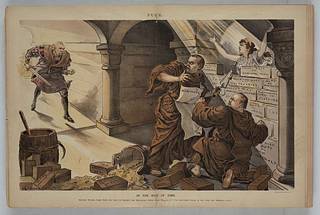
In the nick of time / Keppler, Jr.
Summary
Print shows two medieval monks labeled "McKinley" and "Reed" constructing a wall using blocks labeled "War Tax on Dinner Pails, Heavy Duty on Laborers Tools, Prohibitory Duty on Necessaries, High Duty on Raw Materials, Unjust Tax on Farmers Implements, Burdensome Tariff on Clothing, Duty on Iron, Duty on Steel, [and] Class Legislation" and cement labeled "Monopoly Mortar" to bury alive a female figure labeled "American Industries"; arriving "in the nick of time" is William L. Wilson with a sword labeled "Wilson Bill" to put a stop to the punishment and torture of "our industries".
Caption: Rescurer Wilson comes none too soon to prevent the Republican monks from walling up our industries alive, in the true old Mediæval style.
Illus. from Puck, v. 35, no. 886, (1894 February 28), centerfold.
Copyright 1894 by Keppler & Schwarzmann.
Alois Senefelder, the inventor of lithography, introduced the subject of colored lithography in 1818. Printers in other countries, such as France and England, were also started producing color prints. The first American chromolithograph—a portrait of Reverend F. W. P. Greenwood—was created by William Sharp in 1840. Chromolithographs became so popular in American culture that the era has been labeled as "chromo civilization". During the Victorian times, chromolithographs populated children's and fine arts publications, as well as advertising art, in trade cards, labels, and posters. They were also used for advertisements, popular prints, and medical or scientific books.
Tags
Date
Contributors
Source
Copyright info

































